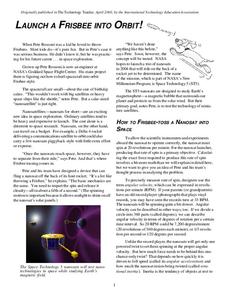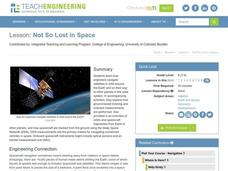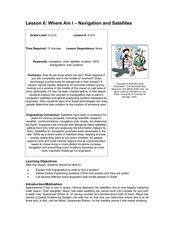American Museum of Natural History
Field Trip Earth
Take a field trip around Earth by way of satellite images. Learners watch a video lesson that describes different images taken from orbiting satellites. They then test their visual skills in a 14-question online quiz.
Curated OER
Orbit an Artificial Satellite
Students construct an artificial satellite from random materials. They demonstrate the principle of an orbit. Students are divided into small groups. Each group creates a model of an artificial satellite in orbit.
Curated OER
Orbiting Satellites
Eleventh graders explore the concept of orbits. In this Algebra II lesson, 11th graders investigate Earth-orbiting satellites as they use algebraic thinking to calculate altitude and velocity.
Curated OER
Sea Ice and Satellites
Students study satellites and satellite images using Google Earth. In this satellite lesson, students discuss satellites and how they work. Students watch a demonstration of how satellites work and learn what they are used for. Students...
Curated OER
Digital Images: From Satellites To The Internet
High schoolers examine digital images and how satellites orbiting Earth send information and pictures to Earth over the Internet. They use a digital camera to put pictures on a computer and decode a satellite image from space.
International Technology Education Association
Launch a Frisbee into Orbit!
How fun it must be to play Frisbee in space! That is just what a NASA engineer gets to do, and you can learn how, too. Follow the instructions provided in this informational article to create your own satellite launcher. Afterward,...
Curated OER
Optimization
In this optimization of satellites worksheet, students read about the Octagonal IMAGE satellite and solve 4 problems related to the size and shape of the satellite and the solar cells used to power the satellite. Students find the mass...
Curated OER
How Does a Satellite Stay in Orbit?
Students explore placing a satellite into orbit, then about forces needed to keep an object in orbit. They examine how satellites orbit in elliptical paths and about properties of ellipses. They learn Kepler's 3rd Law of Planetary Motion
Curated OER
Not So Lost in Space
Students investigate how engineers navigate satellites in orbit around the Earth and on their way to other planets in the solar system. They study vocabulary words and participate in studying a satellite by learning about times and...
Curated OER
Unit VIII: Worksheet 3 - Central Force
Beginning physicists imagine being aerospace engineers by solving seven centripetal force problems. They calculate the work, speed, time, and acceleration of objects in orbit: a satellite around Earth, and Earth around the sun. This is a...
CK-12 Foundation
Newton's Cannon
Gravity does more than keep our feet on the ground — it holds a satellite in orbit, too. Help learners understand the effects of gravity on an orbiting object through a simulation activity. Individuals adjust a launch speed and watch as...
Curated OER
Comparing the Satellite and Broadcast Radio Landscapes
Learners research the development of satellite technology over the last 50 years students explain how the enactment of the Telecommunications Act of 1996 changed the rules for corporate ownership of multiple media outlets.
Curated OER
Satellite Drag and the Hubble Space Telescope
In this satellite drag and Hubble space telescope worksheet, students solve two problems using a graph showing the altitude of the satellite vs. the year with two lines showing two different types of re-boost and one line without...
Curated OER
A Matter of Timing
In this orbital period activity, learners solve 2 problems about satellites and their orbits. They determine how many days it takes for two satellites to be in "opposition", they find the least common factor between their orbit periods...
Curated OER
Cities and Seasons
Students explore how satellite images show seasonal changes in seven cities in North and South America. Through a sequence of images, they study the green-up and brown-down of the seasons and how seasons change over time. Afterwards,...
Space Awareness
Sun, Earth and Moon Model
The moon orbits Earth while the Earth is rotating, and the Earth revolves around the sun. This can be a tricky concept for young astronomers. Implement an activity that helps distinguish between the movements of Earth's systems around...
NASA
Rendezvous For Two
Imagine the challenge of getting the space shuttle to rendezvous with the International Space Station. Groups must determine the elliptical transfer orbit needed to get the space shuttle from its orbit to the orbit of the International...
NASA
It All Comes Full Circle
How long does it take spacecraft go around the earth? Using the circular orbits of the space shuttle and the International Space Station, groups determine the distance traveled in one revolution, then calculate the distance traveled...
International Technology Education Association
Pixel This!
Did the image I drew match the image you saw? By simulating a satellite and a ground station, teams of two transmit data in the form of pixels in order to recreate an image. They use four different levels of brightness, creating slightly...
American Museum of Natural History
Train of Thought
Hop aboard the train of thought. A remote learning resource has learners consider thought experiments to consider scientific theories. It provides two examples, one on orbiting bodies and the other on the speed of light, for them to work...
Curated OER
Tracking Satellites Using Latitude and Longitude
High schoolers, viewing an Internet site, plot the path of several satellites using latitude and longitude over the course of an hour. They learn the four basic types of satellites and their purpose.
Curated OER
Where Am I: Navigation and Satellites
Students explore the concept of triangulation that is used in navigation satellites and global positioning systems designed by engineers. They determine ways these technologies can help people determine their position or the location of...
Curated OER
TE Lesson: Navigating at the Speed of Satellites
Students study the basic concepts of the Global Positioning System and how it increases the accuracy of navigation. They examine trilateration and how the speed of light is used to calculate distances.
Curated OER
Keep in Touch: Communications and Satellites
Students investigate how satellites help people communicate with others far away and in remote areas. They discuss a scenario of someone travelling to an area with no mode of communication, observe a teacher demonstration, and create a...

























